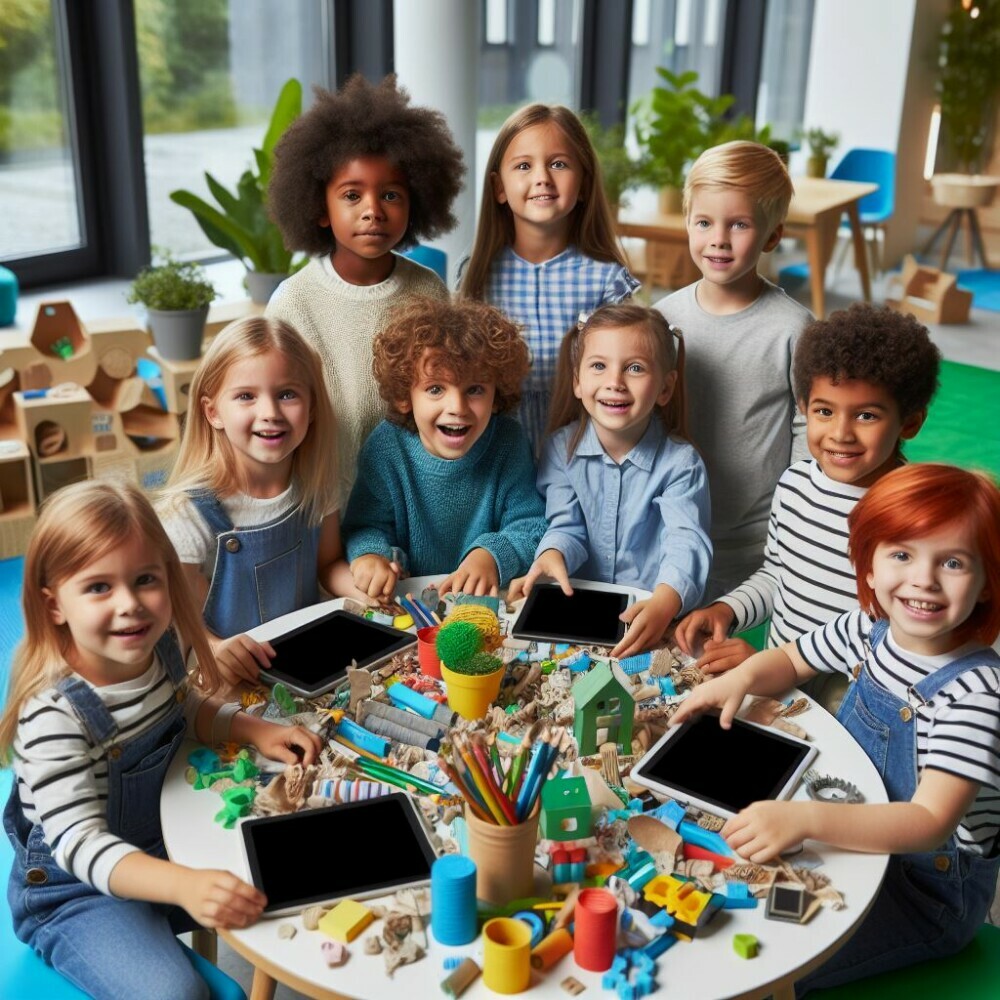Table of Contents
Introduction
If you’re wondering WHY it’s critical to educate children about environmental conservation, the answer is simple. Our future depends on the next generation’s dedication to preserving the planet. That’s why, educating children and environmental conservation go hand in hand. By teaching kids the value of sustainability, we’re setting the stage for a healthier Earth.
Now how do we introduce such a monumental topic to the young and curious minds? It starts with our approach. For toddlers and preschoolers, nature walks and simple conversations about plants and animals do wonders. School-age children can handle more complex discussions on topics like water conservation and pollution.
I’m a big fan of using storytelling to create a vivid picture of what conservation means. For instance, a story about a dolphin affected by ocean trash can spark empathy and a desire to protect wildlife. And don’t underestimate the power of playtime. Hands-on activities like sorting recycling or gardening can instill lasting eco-friendly habits.
Remember, this isn’t just about feeding them facts; it’s about sparking genuine interest and understanding. With these methods, you can ignite a passion for environmental stewardship that will grow as they do.
Fun Activities That Teach Sustainability

I’m going to let you in on some of the most engaging ways to teach your kids about sustainability. And guess what? They are straightforward and enjoyable for the entire family. Choose something that resonates with you and your children’s interests.
Crafting with recycled materials isn’t just a creative exercise; it’s a practical lesson in sustainability. Show your kids how to turn old newspapers into paper mache sculptures, or make collage art from magazines. This teaches them the value of repurposing and gives discarded items a second life.
Setting up a home garden can be both fun and enlightening. It teaches children about the growth cycle of plants and the role they play in the ecosystem. They’ll learn how growing your food reduces carbon footprints and can lead to healthier eating habits. Plus, who doesn’t love tasting the fruits of their labor?
Don’t worry too much about getting it perfect on your first attempt; gardening is a learning experience. You can always adjust your approach down the road.
Taking your kids on environmentally-themed field trips can open their eyes to the larger picture of conservation. Visit a local recycling center, a wildlife refuge, or a botanical garden. Expose them to nature’s diversity and encourage questions about the environment. This hands-on experience can spark lasting interest and respect for nature.
Remember, the goal is to integrate these activities seamlessly into their lives, reinforcing the concept that sustainability isn’t a chore, but a normal part of our daily existence. That’s going to include meshing these activities into our routine, which is what I’ll cover in the next section.
Integrating Eco-Learning into Daily Routines

Now, if you want to weave environmental conservation into the fabric of everyday life, start with the household basics. When children see eco-friendly practices as part of normal routines, they’re more likely to carry them into adulthood. It’s worth the effort to lay the groundwork now for environmentally conscious behaviors that last a lifetime.
You’re going to find out about the simple power of the Reduce, Reuse, Recycle principle. Make it a fun, collaborative affair with your kids. For example, turn a regular evening into a ‘Sort-the-Recycling’ night with rewards for separating plastics, papers, and metals correctly. This isn’t just about sorting waste; it’s also about understanding the lifecycle of materials and why recycling is crucial.
Next, let’s tackle energy and water conservation. Replace those old-fashioned reminders to turn off the lights with a ‘Lights-Out Leader’ chart, where your kids can earn points for conserving electricity. When it comes to water, experiment with timing showers or turning off the tap while brushing teeth. Embedding these practices into routines playfully encourages kids to be mindful about resources.
Making sustainable food choices can also be an enlightening journey for the family. From selecting local produce at the farmer’s market to understanding the impact of meat production on the environment, choosing what you eat is a chance to discuss broader issues. Break it down for them: why eating plant-based meals once a week can benefit the planet or why we pick organic apples over the shiny, waxed ones.
This thread of conservation learning doesn’t end when the day is done; it extends to choosing educational resources and tools as well. In the next section, you’re going to see how the right books, games, and local community involvement can bolster a child’s understanding and passion for environmental conservation.
Educational Resources and Tools for Environmental Learning

I’m here to help you with a list of educational resources and tools designed to make learning about environmental conservation engaging and memorable for children. It’s crucial to have a mix of resources at your disposal to cater to different learning styles and interests.
Guess what? Books and documentaries that are aimed at young audiences can be powerful tools for introducing complex environmental issues in a simple and relatable way. I’m talking about storybooks that weave conservation messages into their narratives, or visually-rich documentaries that show the beauty of nature and the impact of human actions on the planet.
But in today’s digital age, it isn’t just about books and videos. Interactive apps have popped up that teach children about ecology, wildlife, and conservation through games and quizzes. These digital platforms can be a fantastic way to provide hands-on learning experiences from anywhere.
And your local community likely has valuable resources that are just waiting to be tapped into. Nature centers offer programs for kids to experience wildlife firsthand, while libraries often host environmentally themed story sessions and workshops. It’s a chance to connect book learning with real-world experiences.
If you want to take things a step further, talk to your child’s school about integrating these resources into their curriculum. Some schools may even have programs or partnerships with local environmental organizations. Who knows? Your initiative could lead to a school-wide eco-learning project.
Empowering Kids to Take Action: The Role of Community and School Projects

When it comes to environmental conservation, keeping kids informed is just one piece of the puzzle. A critical step is empowering them to transform knowledge into action. Community and school projects offer fantastic opportunities for children to engage with the principles they’ve learned about in a hands-on way.
I’m going to explain how encouraging your children to participate in community cleanup and tree planting initiatives not only allows them to make a positive impact on the local environment but also helps foster a sense of environmental stewardship. It’s a chance for them to see firsthand the difference they can make.
Schools offer another powerful platform for environmental action. I’m here to help you understand how school sustainability projects and eco-clubs give children a structured environment in which to apply their eco-knowledge. Here, they can collaborate with peers, spark creative ideas, and take leadership roles in environmental campaigns.
Also, incorporating the celebration of environmental holidays and awareness days into your child’s calendar can heighten their appreciation for the natural world. Events such as Earth Day and Arbor Day become opportunities for reflection, learning, and contribution.
By instilling an environmental ethic from an early age, children are more likely to carry these ideals into adulthood. Giving them the tools, opportunities, and encouragement to take part in community efforts now will help ensure they become the environmentally conscientious leaders of tomorrow. Choose something that resonates with your family and watch as your children grow into passionate advocates for our planet.
If you are looking for a guide on how to choose best educational books for according to your children’s age, please click here🙂
Kay,
greenlifehub.com

